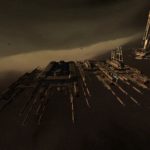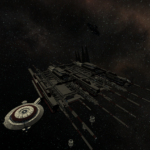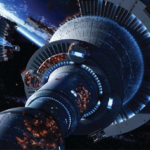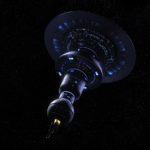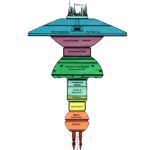This webpage introduces more about all the livable constructs floating out (what we call / think of as “down”) in Space.
–
Table of Contents:
- Vocabulary
- Dimensions
- List of Deep Space Stations by Type
- Exterior Examples (Images Begin)
- Interior Examples
–
Vocabulary:
space sta·tion
-
a large artificial satellite used as a long-term base for manned operations in space.
This list will include the Deep Space stations; those in the Oort (the asteroid/comet/planetoid-laden border of our (and each) solar-system), the Interstellar Mediums (the areas/regions/volumes of Space between the solar-systems), and even out between the galaxies (where sometimes dark-galaxies occur; some cannot be seen by human eyes, even when they aren’t being cloaked or otherwise hidden).
–
Dimensions:
Space stations can be anything from the International Space Station the public knows about today (which is essentially a few bus-sized cylindrical capsules/modules linked together), all the way up in size to a Dyson Sphere (a mega-structure that completely encompasses a star and captures most or all of its power output). The majority of Space stations house at least a few dozen workers. Some are spacious and supplied enough to house hundreds, thousands, millions, or even billions; some are the size of cities and more.
You can expect corridors or connecting rooms in them to relate proportionately to their overall size; Space stations meant for a few dozen people will have hallways and intersections comparable to those in houses or schools, while Space stations meant for more traffic, or larger traffic (i.e. vehicles in them, not just people), will have hallways and intersections more like those you might find in a big sports stadium or series of interconnected factories and warehouses used by the same corporation. Even crawl-spaces for service/maintenance vary that greatly; smaller Space stations will require human-sized users to literally crawl through their maintenance panels and tunnels, while larger Space stations will have enough room for beings of that height and frame to reach up or even jump around. Generally you should plan for something in that range; don’t try to get more than your teammates on foot into the smaller stations, but feel free to see if you can maneuver trucks and tanks through the bigger ones.
The dimensions of controlled airspace (or, more accurately in this case, just Space; there is no air out there –at least not in this modern era) also differ significantly; some Space stations have no control over the space/Space around them, but any Space station with precious/valuable or sensitive/classified cargo and/or personnel will. With small stations, you can likely fly right up to them. Medium-sized stations may want you to slow or stop your Spacecraft several kilometers away. Larger stations will almost certainly require you to slow/stop as many as 100 kilometers away, sometimes even maneuvering into a line of other Spacecraft waiting for docking assignments/permission.
–
List of Deep Space Stations by Type
Fully Mobile:
- Inisfree’s MSBSs, PSBSs, & SSBSs
- Phobos & Deimos
- the moon-sized ships siphoning solar flares from the Sun and other stars
- the entire Moon is also one; artificial
- [Name TBA]
- [Name TBA]
- Each system with an asteroid belt now has dozens.
- [Name TBA]
- [Name TBA]
- CLASSIFIED (many of the Dark Fleet installations are in this category)
- [Name TBA]
- [Name TBA]
- All known Mass Relay ruins are listed on the Milky Way Galaxy map page.
- [Name TBA]
- [Name TBA]
- Every listed star system now has 1+ in outer orbit.
- [Name TBA]
- [Name TBA]
- Every listed star system now has 1+ in outer orbit.
- [Name TBA]
- [Name TBA]
- Every listed system cluster now has 2+.
- [Name TBA]
- [Name TBA]
- Every listed system cluster now has 1+.
- [Name TBA]
- [Name TBA]
- Every listed star system now has 1,000+.
- [Name TBA]
- [Name TBA]
- Every listed star system now has 500+.
- [Name TBA]
- [Name TBA]
- Every system cluster now has one, but their locations are kept as Sensitive Compartmentalized Information (SCI) only available to certain high-ranking federal and law enforcement personnel.
- [Name TBA]
- [Name TBA]
- (these change regularly; check for status updates with local Space authorities)
- [Name TBA]
- [Name TBA]
- Every listed star system now has 3+ in outer orbit.
- [Name TBA]
- [Name TBA]
- Every listed star system now has 1+ in outer orbit.
- [Name TBA]
- [Name TBA]
- Every listed star system now has 3+ in outer orbit.
- [Name TBA]
- [Name TBA]
- Every listed star system now has 5+ in outer orbit.
- [Name TBA]
- [Name TBA]
- Every listed star system now has 1 in outer orbit.
–
More TBA…
–
Exterior Examples:
–
Interior Examples:
–

